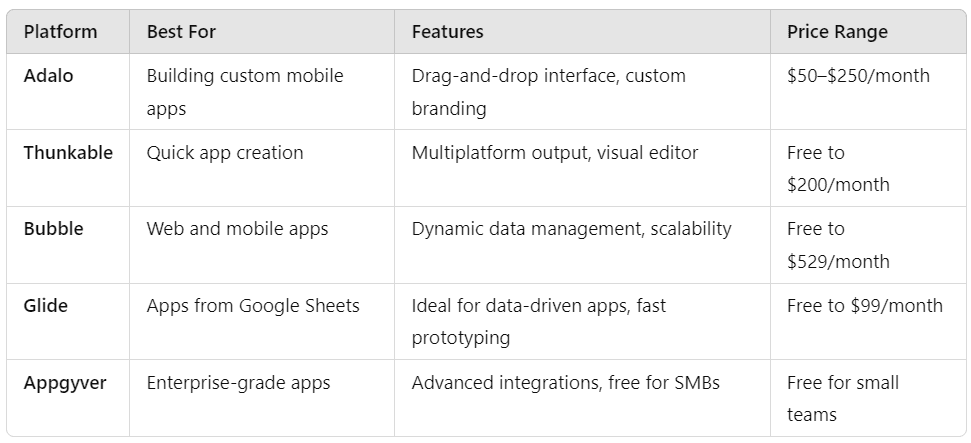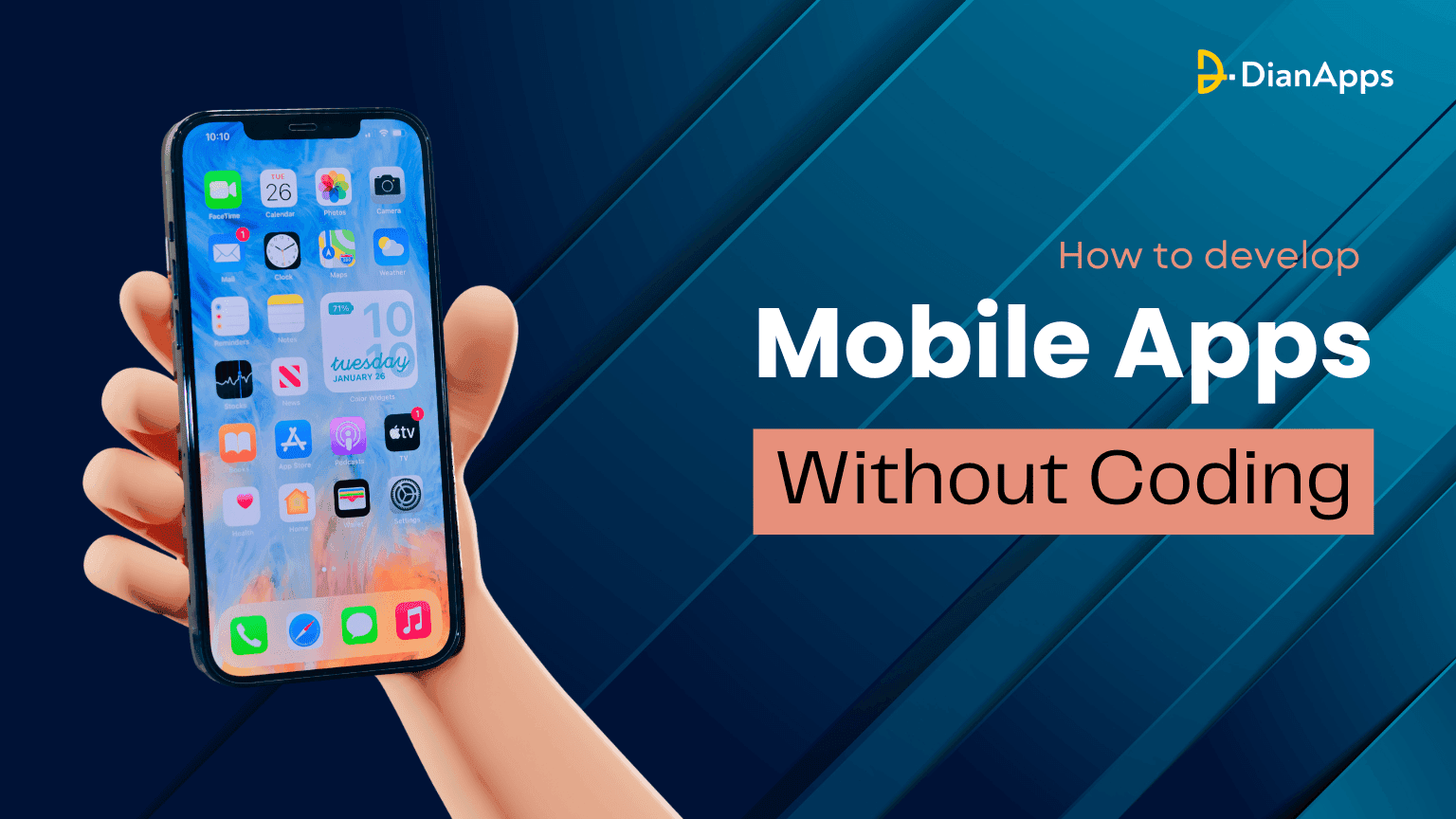A mobile app is no longer a luxury—it’s a necessity. Businesses, regardless of their size or industry, are leveraging mobile apps to connect with customers, streamline operations, and enhance brand visibility. However, traditional app development has long been the domain of experts, requiring the best programming languages knowledge, access to skilled developers, and significant financial investment.
For small business owners, entrepreneurs, or even enterprise teams without a dedicated tech department, the challenge is real:
- Time: Developing a robust mobile app can take months or even years.
- Cost: Hiring a mobile app development company or building an in-house team often exceeds budgets.
- Technical Expertise: Many businesses simply lack the coding expertise required to bring their app vision to life.
But what if you could bypass all these obstacles? Enter no-code platforms—a revolutionary approach to app development that enables anyone to build apps without writing a single line of code.
This guide will help you navigate the world of no-code platforms, providing step-by-step instructions, tools, and insights to create your app with minimal hassle.
The Rise of No-Code Platforms: Empowering Businesses
What Are No-Code Platforms?
No-code platforms allow users to create functional mobile applications using pre-built modules, drag-and-drop interfaces, and templates. They eliminate the need for programming knowledge, empowering non-technical users to bring their ideas to life.
Why Businesses Are Turning to No-Code Solutions
Reduced time to market
Developers frequently compromise functionality for speed when creating corporate apps, or the other way around. Consumers of today demand seamless cross-platform experiences and fast app delivery. Developers want to get items into the market as soon as possible in order to meet demand, yet time is sometimes a major limitation.
Also read the importance of cross-platform mobile app development!
Non-developers may complete projects in a fraction of the time with no code. The creation of ideas and applications is facilitated by the visual interfaces. With less hassle, products reach the market more quickly.
Updates are simple to make.
Updates are occasionally necessary for applications in order to add new features, fix issues, and other improvements. In the past, this was a laborious procedure that occasionally involved bringing down the program.
No-code apps are not subject to these limitations. While the program is being used, new features might be introduced. Additionally, improvements are being deployed more quickly than in the past. Agility is necessary in today’s economic climate, and no-code helps companies become more flexible.
Continue reading Agile methodology here!
Improved cooperation
There is some disconnection between business units and IT when traditional app development is used. Directives are outlined by business divisions and then sent to IT, which creates applications that may or may not meet expectations. Without cooperation, projects are delayed, and the outcomes may be excellent.
Platforms without code encourage openness and cooperation between teams. Real-time visibility into IT’s work is available to business teams. Projects are finished on schedule and nothing is lost in translation. Additionally, engineers and business analysts may participate and help make a project a reality because coding is not required.
Savings
Specialized engineers are needed for complex coding tasks, and applications also require upkeep. Legacy system maintenance can deplete firm finances and IT resources. More code is needed to alter or fix a complex application. Legacy apps may need to be maintained simply by an organization.
Legacy code maintenance is eliminated with no-code. Additionally, the platforms may be used in conjunction with current business systems, enabling developers to modify what doesn’t function and preserve what works.
Get rid of shadow IT
In order to supply solutions more quickly, some business users adopt solutions that IT has not approved. According to Gartner research, 41% of non-developers create their own solutions. Under the close supervision of the IT department, no-code citizen development makes development easier. IT has the freedom to rule, while business users have the freedom to create. Transparency and cross-team cooperation are present.
Simple guidelines are provided by no-code app development so that non-IT staff may create applications. By offering such tools, a company allows innovative staff members to create apps in a regulated setting that has IT approval.
Step-by-Step Guide to Building a Mobile App Without Coding
Step 1: Define Your App’s Purpose and Goals
Start by asking yourself these critical questions:
- What problem does the app solve for your users?
- What core features are necessary for its functionality?
- How will the app align with your business goals?
For instance:
- A fitness trainer might need an app for scheduling classes and offering workout tutorials.
- A restaurant owner might want an app for online orders and loyalty programs.
Want to build a food delivery app? Let’s get started!
Creating a clear roadmap helps you stay focused and simplifies the development process.
Step 2: Choose the Right No-Code Platform
There are many no-code platforms available, each catering to different needs. Here are some popular options:

How to Choose:
- For e-commerce, look for platforms with payment gateways.
- For data-heavy apps, prioritize database integration.
- Consider scalability if you expect rapid growth.
Also know some low-code platforms!
Step 3: Design an Intuitive User Experience (UX)
Even with a no-code platform, app design is crucial for user engagement.
- Wireframe Your App: Use tools like Figma or Canva to sketch out your app’s layout and flow.
- Prioritize Simplicity: Ensure navigation is intuitive. Avoid cluttered screens or excessive steps for tasks.
- Maintain Brand Consistency: Use your business colors, logo, and fonts.
Pro Tip: Refer to user interface (UI) trends, such as minimalistic design and dark mode, to enhance usability.
Step 4: Build Your App with No-Code Tools
Here’s how most no-code platforms guide you through the process:
1. Select a Template:
Choose a template that aligns with your app’s purpose—e.g., food delivery, booking, or social networking.
2. Drag and Drop Features:
- Add elements like buttons, text fields, images, and forms.
- Integrate functionalities such as GPS tracking, push notifications, or in-app chat.
3. Configure Data Sources: Link your app to Google Sheets, Airtable, or external databases for dynamic data updates.
4. Test Thoroughly: Use the platform’s simulator to test every feature. Collect feedback from stakeholders or beta testers to identify improvements.
Step 5: Publish Your App
Once the app is polished and tested:
- Export the app for iOS and Android.
- Follow the guidelines for submitting apps to the App Store and Google Play.
- Use the no-code platform’s deployment tools for seamless submission.
Common Features to Consider in Your App
- User Authentication: Secure logins with email or social accounts.
- Push Notifications: Keep users engaged with alerts.
- Payment Integrations: For apps involving purchases.
- Analytics Tools: Monitor performance and user behavior.
- Offline Mode: Ensure usability without internet access.
Overcoming Challenges in No-Code Development
Limited Customization:
No-code platforms might not support highly specific requirements. Partnering with a software development partner can help bridge gaps.
Scalability Concerns:
While suitable for SMBs, larger businesses may need to transition to custom software solutions for advanced needs.
Learning Curve:
Though easier than coding, mastering no-code tools still requires effort. Explore tutorials, forums, and documentation.
Real-World Success Stories
1. Fitness Start-Up Enhances User Engagement
A fitness studio launched an app using Glide to manage bookings, track progress, and send workout reminders. User retention improved by 40%.
2. Restaurant Streamlines Orders
A local eatery created a delivery app on Thunkable, integrating payment and GPS tracking. The app increased online sales by 50%.
3. Non-Profit Organization Raises Awareness
A non-profit used Bubble to develop an app for showcasing projects and collecting donations. Donor engagement doubled within three months.
When to Seek Professional Help
If your app has complex needs, consulting a custom software app development company is wise. Scenarios include:
- Integration with advanced technologies like AI or IoT.
- Large-scale performance requirements.
- High customization demands for branding and user experience.
Also know about low-code app development
Future of No-Code Platforms
The future of app development will see even greater advancements in no-code technology:
- AI-Powered Development: Platforms suggesting features based on industry-specific needs.
- Voice and Gesture Integration: Simplifying interactions for accessibility.
- Seamless Data Management: Enhanced tools for syncing real-time data.
Conclusion: Empower Your Business with No-Code
No-code platforms are leveling the playing field, enabling businesses of all sizes to embrace mobile technology without the barriers of cost and complexity. With the tools and strategies outlined in this guide, you can create an app that enhances customer engagement, streamlines operations, and drives growth.
While no-code solutions are powerful, don’t hesitate to collaborate with a mobile app development company or leverage custom software app development services when your business requires a tailored approach. The key is to act now—because in today’s world, having a mobile app is not just an advantage; it’s a necessity.
Let your creativity flow, and watch your business thrive in the app-driven economy!










Leave a Comment
Your email address will not be published. Required fields are marked *